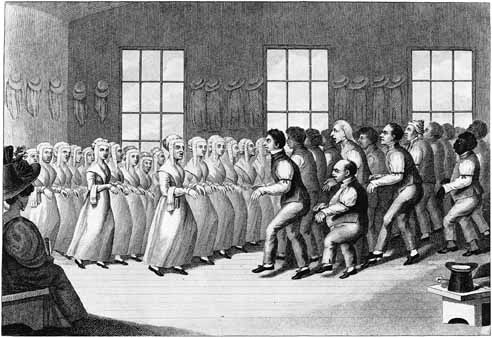 The Shakers were surely the oddest and most compelling of early American religious movements. They were a late-18th-century offshoot from the Quakers. They took root in America during the Revolution. And they held some fascinating beliefs.
The Shakers were surely the oddest and most compelling of early American religious movements. They were a late-18th-century offshoot from the Quakers. They took root in America during the Revolution. And they held some fascinating beliefs. God was both father and mother. The second coming was imminent, and Christ would come as a woman. Out of a belief in song and dance they created wonderful music. They practiced a communal life. Finally, they believed in total sexual abstinence.
Still, the Shakers had a fine creative cutting edge. An 1859 book of doctrine begins with lines from the Apocrypha: "O my soul, swallow down understanding, and devour wisdom ..." They did just that. They mixed simplicity and industry with wonderful creative openness. Invention flowed from that mix.
For example, the buzz-saw appears to have been a Shaker invention. Half the motion of regular saw is wasted. You don't cut on the backstroke. We're told about Sister Tabitha who had a vision. She saw the action of a saw merge with that of a spinning wheel. She realized she could make the sawing motion continuous by forming the saw into a rotating disc.
Maybe Tabitha's vision is myth -- maybe not. But wonderful things certainly did flow from Shaker vision. At first they avoided patents as a worldly pursuit. But the outside world made good use of their ingenuity. The familiar flat broom we all use is a Shaker invention. So are the clothespin and the apple corer.
The Shakers finally did join the patent process with every kind of machine for weaving cloth, shaping wood, and preparing food. Still, it's not Shaker devices that take our breath away. It is Shaker design.
Their furniture and architecture have such elegance and simple beauty. They have a cool, lean, soul-settling grace that rises within a life where there is no worldly future.
Yet that's why the Shakers perished. You might think celibacy killed them off. But it didn't. The Shakers lasted over a century by simply taking new people in. Celibacy was one more simplification that many people found attractive.
No, the modern world broke through in the Civil War. Their towns lay in the way of plundering armies. The War drew men off to fight, and they didn't come back. The Shakers' static agrarian ways stopped attracting people from mainstream America. Only orphans and the old came to them.
So they faded away. But they left a lingering legacy of design -- a simple gift of grace and balance. And that gift still haunts us -- long after they've gone.
source: Engines of Our Ingenuity
What does this have to do with dance, you ask?
Are you familiar with Aaron Copland's Appalachian Spring? Does this (I hope) remind you of Martha Graham? It is probably the most well known section of a composition is based on the Shaker melody 'Tis a Gift to be Simple, a tune also known today as Lord of the Dance.
Martha Graham (1894-1991) and
Erick Hawkins (1901-1994) in
premiere of Appalachian Spring, October 30, 1944

This photograph was taken at the first performance of Appalachian Spring in the Library's Coolidge Auditorium on the eightieth birthday of Elizabeth Sprague Coolidge, who had commissioned a score from Aaron Copland to accompany modern dance choreography by Martha Graham. Copland, originally titling the piece "Ballet for Martha," drew on the traditional Shaker composition "Simple Gifts." Graham incorporated characteristic American gestures into her unique dance vocabulary. Together, Copland and Graham ushered an American vernacular into the fine arts.
 And when discussing Shakers and dance one MUST remember Doris Humphrey. Here is an excellent look at Humphrey's impact on modern dance. The Shapes of Change: Images of American Dance. I remember learning and performing this dance -- it was difficult and demanding. I was surprised because it was deceptively simple from an audience viewpoint!
And when discussing Shakers and dance one MUST remember Doris Humphrey. Here is an excellent look at Humphrey's impact on modern dance. The Shapes of Change: Images of American Dance. I remember learning and performing this dance -- it was difficult and demanding. I was surprised because it was deceptively simple from an audience viewpoint!
We learned it through Laban notation. Very cool! We were blessed to be part of a generation that fully utilized that dance notation system.
<~~ This is an example of dance notation.
The Shakers, or the United Society of Believers in Christ's Second Coming, were founded by "Mother Ann Lee, a stalwart in the "Shaking Quakers" who migrated to America from England in 1774. American Shakers shared with the Quakers a devotion to simplicity in conduct and demeanor and to spiritual equality. They "acquired their nickname from their practice of whirling, trembling or shaking during religious services." The Shakers used dancing as a worship practice.
No comments:
Post a Comment